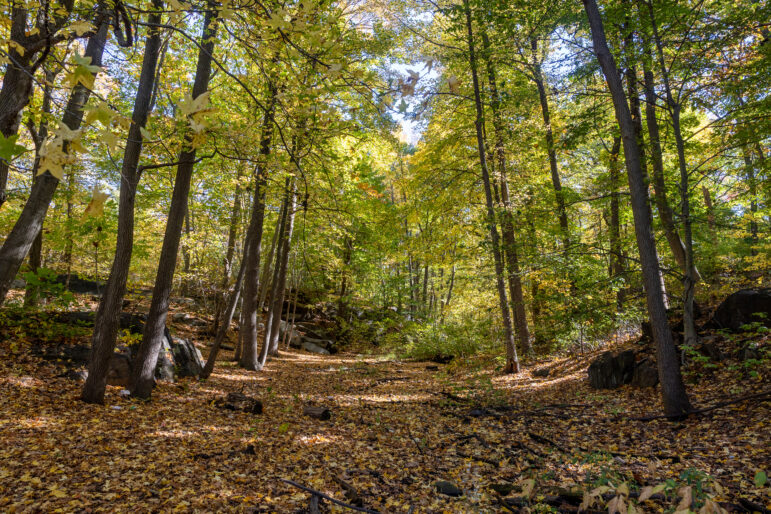Gathering data from satellites and sensors placed on trees, the study measured temperatures across different types of urban green spaces in 12 U.S. cities, including New York. It found that the air temperature was cooler in forests compared to landscaped trees at over 90 percent of locations examined.

Natural Areas Conservancy (NAC)
Seton Falls Park in the Bronx. The study found that air temperature there was 79 degrees in the forest on July 21, a 12 degree difference from temperatures on the street that day.New data is in that says to head for the trees to beat the summer heat.
A report from Natural Areas Conservancy (NAC) released in July found that urban natural areas—which include forests, wetlands and grasslands—represent the coolest places in cities across the country. New York City has around 20,000 acres of natural areas, or 11.6 percent of the city’s land cover.
“What this study shows is the true impact of green space on people’s comfort levels during the summer,” said Sarah Charlop-Powers, executive director for the NAC.
According to an EPA study, extreme heat is the leading cause of weather-related deaths in the U.S. As summer temperatures continue to escalate in the face of climate change—July 2023 was the hottest month on record—NAC’s study underscores why maintaining and expanding green spaces is more important than ever.
“I think the significance of this report is just highlighting that nature can be part of the solution to heat mitigation,” said Clara Pregitzer, NAC’s deputy director of conservation science. Green spaces also offer other advantages beyond just cooling, added Pregitzer, such as biodiversity benefits, recreation benefits, and mental health benefits.
To help compile the report, NAC recruited partners from their Forests in Cities Network, which promotes healthy forested natural areas in cities. Gathering data from satellites and sensors placed on trees, the network of experts measured land surface and air temperatures across different types of urban green spaces in 12 U.S. cities—including New York.
The results showed that air temperature was cooler in forests compared to landscaped trees at over 90 percent of the 40 locations studied. Healthier forests—which boast higher rates of canopy cover and native species—typically performed better than degraded forests which tend to lack these characteristics.
In New York City, NAC teamed up with NYC Parks to collect data from Clove Lakes Park on Staten Island, Seton Falls Park in the Bronx, and Forest Park in Queens.
“We are excited to see the results of the Cooling Cities report, which both reinforces our own understanding of the importance of natural areas, and highlights the essential work we do to protect and expand these areas,” said NYC Parks Deputy Commissioner for Environment and Planning Jennifer Greenfeld.
According to one staggering finding, on July 21 at Seton Falls Park, the air temperature on the street was 91 degrees compared to 79 degrees in the forest, a 12 degree difference.

Natural Areas Conservancy (NAC)
A report from Natural Areas Conservancy (NAC) released in July found that urban natural areas—which include forests, wetlands and grasslands—represent the coolest places in cities across the country.Shannon Jordy, deputy director of communications and external affairs at NAC, pointed out that while forested areas tend to be the coolest, other green spaces play an important role in mitigating climate change.
“The intent of this report is not to pit green space against green space,” she said. “We know we need all of the strategies in our tool belt in order to tackle climate change and extreme heat.”
Cities experience higher temperatures on average due to what’s called the “urban heat island effect.” According to a 2022 study by the Joint Research Centre,* cities can be up to 27°F warmer than nearby rural areas. New York City has the third most intense urban heat island effect in the U.S., after Newark, N.J. and New Orleans, LA.
Members of the NAC say the findings in this report make it clear that urban natural spaces should be built into cities’ climate action plans. The nonprofit is calling on New York City to support Int 1065, which would help the city reach its goal of 30 percent tree canopy cover by 2035. They are also echoing other environmental groups’ rallying cries to dedicate one percent of New York City’s budget to the Parks Department.
According to research by the NAC, just 0.7 percent of NYC Parks’ expense budget is earmarked for the care of forested natural areas, despite the fact that they comprise 24 percent of parkland.
*Editor’s note: This story has been updated to correct the source of the study referenced here.








